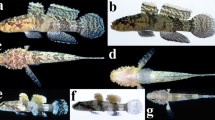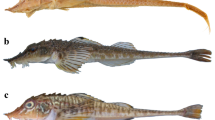Abstract
The poorly known blenny Alticus orientalis Tomiyama 1955 is considered a valid species and redescribed on the basis of 73 specimens (36 males and 37 females), 20.5–83.5 mm in standard length (SL). The species is characterized by the following combination of characters: dorsal-fin spines 14 (rarely 13); pectoral-fin rays 15 (very rarely 14 or 16); pelvic-fin rays I, 4; caudal-fin rays 12 (very rarely 11); supraorbital cirrus finely branched (except in specimens < ca. 20 mm SL); canine-like teeth absent on lower jaw; 1–9 small conical teeth on vomer (rarely secondarily lost); 3 (very rarely 2) pores in mandibular series; pre-anal-fin length 37.6–43.2 (mean 40.4) % SL in males, 39.9–46.9 (43.0) % SL in females; caudal-fin length 19.0–24.2 (21.8) % SL in males, 19.7–25.2 (22.4) % SL in females; pre-anal-fin length / caudal-fin length 1.6–2.2 (1.9) in males, 1.8–2.2 (1.9) in females; cheek without black spots; and head and pectoral fin without small black dots. Although A. orientalis is most similar to Alticus montanoi (Sauvage 1880) [all Japanese specimens previously identified as Alticus saliens (Lacepède 1800) are actually this species], it can be distinguished from the latter by the presence of teeth on the vomer, a greater number of pores in the mandibular series, greater pre-anal-fin length, and slightly shorter caudal-fin length. In addition, genetic analysis supports the divergence of A. orientalis from available sequences from other species of Alticus. In Japanese waters, A. orientalis is distributed around (and probably endemic to) the Izu and Ogasawara islands, whereas A. montanoi is distributed in the Ryukyu and Daito islands.







Similar content being viewed by others
References
Aizawa M, Doiuchi R (2013) Blenniidae. In: Nakabo T (ed) Fishes of Japan with pictorial keys to the species, 3rd edition. Tokai University Press, Hadano, pp 1295–1324, 2101–2105
Allen GR, Erdmann MV (2012) Reef fishes of the East Indies, vols 1–3. Tropical Reef Research, Perth
Bleeker P (1858) Vierde bijdrage tot de kennis der vischfauna van Biliton. Nat Tijdschr Ned Indië 15:219–240
Bleeker P (1869) Description de deux espèces inédites d'Alticus de Madagascar. Verslagen en Mededeelingen der Koninklijke Akademie van Wetenschappen. Afd Nat 3:234–236
Curtiss A (1938) A short zoology of Tahiti in the Society islands. Guide Printing Company, Inc, Brooklyn, New York
Cuvier GL, Valenciennes A (1836) Histoire naturelle des poissons, vol 11. Levrault, Paris
de Beaufort LF, Chapman WM (1951) The fishes of the Indo-Australian Archipelago, vol 9. Percomorphi (concluded), Blennoidea. E. J. Brill, Leiden
Fricke R, Eschmeyer WN, Van der Laan R (2020) Eschmeyer’s catalog of fishes: genera, species, references. http://researcharchive.calacademy.org/research/ichthyology/catalog/fishcatmain.asp. Accessed 15 June 2020
Garman S (1903) Some fishes from Australasia. Bull Mus Comp Zool 39:229–241
Günther A (1868) Additions to the ichthyological fauna of Zanzibar. Ann Mag Nat His 1:457–459
Hall TA (1999) BioEdit: a user-friendly biological sequence alignment editor and analysis program for Windows 95/98/NT. Nucleic Acids Symp Ser 41:95–98
Ivanova NV, Zemlak TS, Hanner RH, Hebert PD (2007) Universal primer cocktails for fish DNA barcoding. Mol Ecol Notes 7:544–548
Klausewitz W (1964) Fische aus dem Roten Meere. VI. Taxionomische und ökologische Untersuchungen an einigen Fischarten der Küstenzone. Senckenberg Biol 45:123–144
Kumar S, Stecher G, Tamura K (2016) MEGA7: Molecular Evolutionary Genetics Analysis Version 7.0 for Bigger Datasets. Mol Biol Evol 33:1870–1874
Lacepède BGE (1800) Histoire naturelle des poisons, vol 2. Plassan, Paris
Mehraban H, Esmaeili HR (2018) Comb-tooth blennies of the intertidal zones of Persian Gulf and Makran Sea: morphology, taxonomy, distribution and conservation status (Blenniiformes: Blenniidae). Iran J Ichthyol 5:192–211
Mochizuki K (1982) A record of the blenniid fish, Alticus orientalis, from Minami-Iwojima Island. In: Nature Conservation Bureau of Ministry of the Environment (ed) Conservation Reports of the Minami-Iwojima Wilderness Area, Tokyo, Japan. Nature Conservation Bureau of Ministry of the Environment, Tokyo, pp 385–389
Patzner RA, Hastings PA, Springer VG, Wirtz P, Gonçalves EJ (2009) List of valid species of blennies. In: Patzner RA, Gonçalves EJ, Hastings PA, Kapoor BG (eds) The biology of blennies. Science Publishers, Enfield, pp 443–473
Randall JE (2005) Reef and shore fishes of the South Pacific. New Caledonia to Tahiti and the Pitcairn Islands. University of Hawaii Press, Honolulu
Randall JE, Ida H, Kato K, Pyle RL, Earle JL (1997) Annotated checklist of the inshore fishes of the Ogasawara Islands. Natl Sci Mus Monogr 11:1–74
Regan CT (1912) New fishes from Aldabra and Assumption, collected by Mr. J. C. F. Fryer. Trans Linn Soc Lond. Second Ser. Zool 15:301–302
Sabaj MH (2019) Standard symbolic codes for institutional resource collections in Herpetology and Ichthyology: an online reference. Ver 7.1 (21 March 2019). American Society of Ichthyologists and Herpetologists, Washington, DC. https://asih.org/sites/default/files/2019-04/Sabaj_2019_ASIH_Symbolic_Codes_v7.1.pdf. Accessed 5 September 2019
Sauvage HE (1880) Description de quelques Blennioïdes de la collection du Muséum d'histoire naturelle. Bull Soc philomath Paris 4:215–220
Senou H (2004) Fishes of Ogasawara Islands. In: Aoyama J (ed) Ogasawara Islands, the "Galapagos of the East" –the attractiveness of endemic species and its crisis–. Kanagawa Prefectural Museum of National History, Odawara, pp 55–62
Senou H, Shinohara G, Matsuura K, Furuse K, Kato S, Kikuchi T (2002) Fishes of Hachijo-jima Island, Izu Islands Group, Tokyo, Japan. Mem Natl Mus Nat Sci 38:195–237
Smith-Vaniz WF, Springer VG (1971) Synopsis of the tribe Salariini, with description of five new genera and three new species (Pisces: Blenniidae). Smithson Contrib Zool 73:1–72
Thompson JD, Higgins DG, Gibson TJ (1994) CLUSTAL W: improving the sensitivity of progressive multiple sequence alignment through sequence weighting, positions-specific gap penalties and weight matrix choice. Nucleic Acids Res 22:4673–4680
Tomiyama I (1955) Notes on some fishes, including one new genus and three new species from Japan, the Ryukyus and Pescadores. Jap J Ichthyol 4:10–13
Wessel P, Smith WHF (1996) A global self-consistent, hierarchical, high-resolution shoreline database. J Geophys Res Solid Earth 101 (B4): 8741–8743
Acknowledgements
We are especially grateful to J. Williams (USNM) who kindly provided his unpublished data for validity of A. montanoi. We thank H. Endo (BSKU), P. Pruvost, R. Causse, Z. Gabsi, and J. Pfliger (MNHN), M. Nakae and G. Shinohara (NSMT), K. Miyamoto (URM), and K. Sakamoto (ZUMT) for providing opportunities to examine specimens; T. Sasaki (Institute of Boninology, Ogasawara Islands) for providing specimens of A. orientalis for DNA analysis; K. Uchino (KPM) for collecting KPM specimens with photography; and volunteers and students of KAUM for curatorial assistance. G. Hardy (Ngunguru, New Zealand) read the manuscript and provided help with English. This study was supported in part by a Grant-in-Aid from the Japan Society for the Promotion of Science for JSPS Fellows (DC1: 19J21103); JSPS KAKENHI Grant Numbers JP23580259, JP26450265, and 20H03311; the JSPS Core-to-Core Program: B Asia-Africa Science Platforms; the “Biological Properties of Biodiversity Hotspots in Japan” project of the National Museum of Nature and Science, Tsukuba, Japan; “Establishment of Glocal Research and Education Network in the Amami Islands” project of Kagoshima University adopted by the Ministry of Education, Culture, Sports, Science and Technology, Japan, and the Sumitomo Fund. Malaysian specimens were collected during the JSPS (the Japan Society for the Promotion of Science, Tokyo, Japan) Asian Core Program, “Establishment of Research and Education Network on Coastal Marine Science in Southeast Asia”, and the JSPS Core-to-Core Program: B Asia-Africa Science Platforms, supported by the Ministry of Higher Education (Government of Malaysia), University Putra Malaysia, and University Malaysia Terengganu.
Author information
Authors and Affiliations
Corresponding author
Additional information
Publisher's Note
Springer Nature remains neutral with regard to jurisdictional claims in published maps and institutional affiliations.
This article was registered in the Official Registry of Zoological Nomenclature (ZooBank) as 42379652-AF35-4D1F-A7C9-C7AE674D9451.
This article was published as an Online First article on the online publication date shown on this page. The article should be cited by using the doi number.
Supplementary Information
Below is the link to the electronic supplementary material.
About this article
Cite this article
Fujiwara, K., Kawama, K., Muto, N. et al. Validity and redescription of the poorly known Japanese blenny Alticus orientalis Tomiyama 1955 (Perciformes: Blenniidae). Ichthyol Res 68, 471–485 (2021). https://doi.org/10.1007/s10228-020-00798-8
Received:
Revised:
Accepted:
Published:
Issue Date:
DOI: https://doi.org/10.1007/s10228-020-00798-8




